Basic QC Practices
2025 Great Global QC Survey Results: Africa
In 2025, the Westgard Great Global Survey assessed the state of QC practices. What's happening in Africa? Are labs in Africa changing more dramatically than anywhere else in the world?
The 2025 Global QC Survey Results: Africa
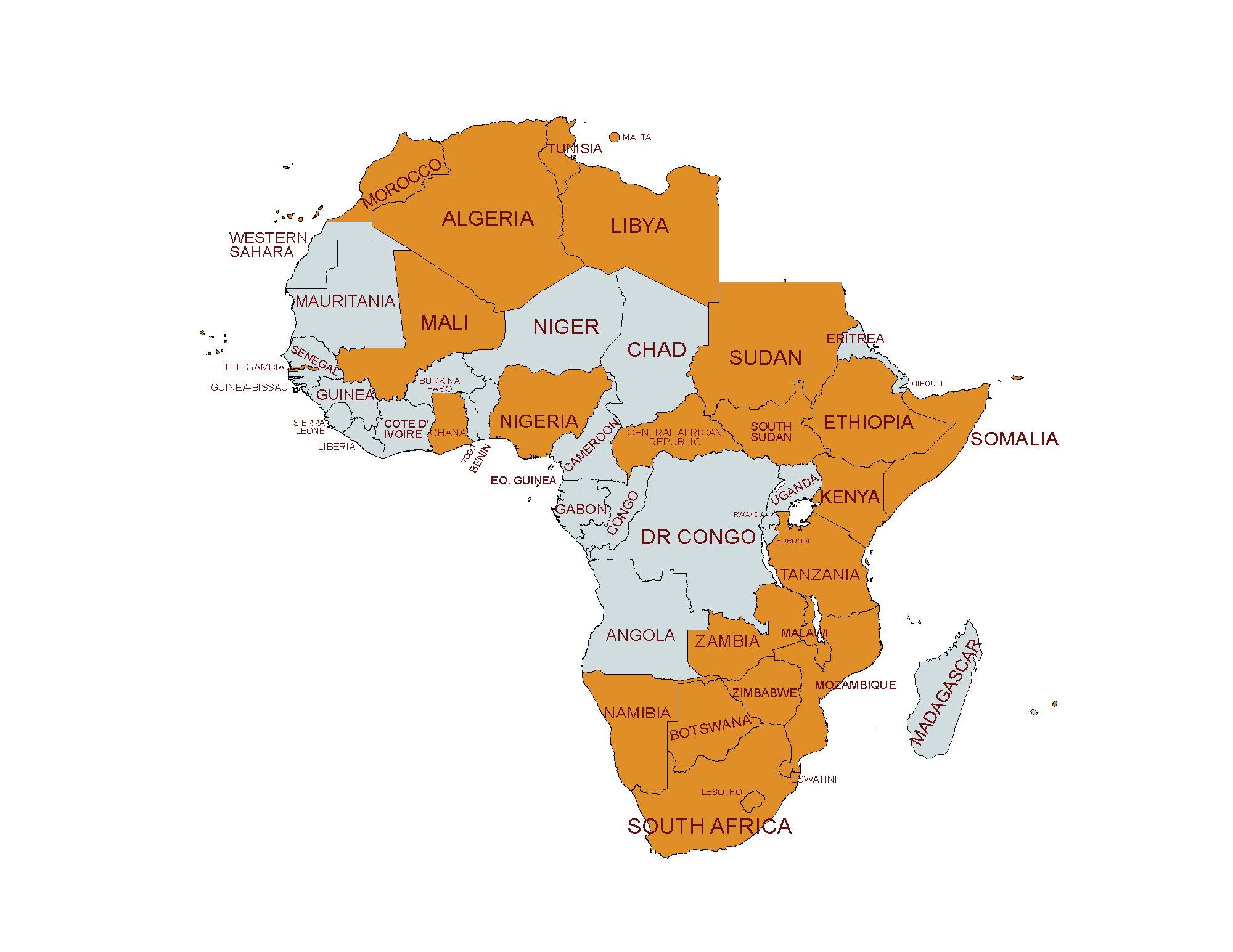
Sten Westgard, MS
September 2025
[This survey was completed with the support and partnership of Thermo Fisher MAS controls.]
In 2025, have QC practices around the world improved or declined?
We surveyed laboratories in 2017 and 2021 about their quality control practices. We did it again in 2025.
We got over 1,280 responses, which break down as follows:
- Africa 118 responses
- Asia 289 responses (note that we include everywhere from India to Australia within this group)
- Europe 143 responses
- Latin and South America 114 responses
- Middle-east 146 responses
- United States and Puerto Rico 440 responses
Asia: 2025 Great Global QC Survey Results: Asia Breakout - Westgard QC
Europe: The 2025 Great Global QC Survey: Europe in isolation - Westgard QC
Middle-East: 2025 Great Global QC Survey Results: Middle East - Westgard QC
Latin and South America: 2025 Great Global QC Survey Results: South and Latin America - Westgard QC
Africa: 2025 Great Global QC Survey Results: Africa - Westgard QC
USA: https://westgard.com/qc-applications/basic-qc-practices/2025-qc-survey-usa.html
All of it together: https://westgard.com/qc-applications/basic-qc-practices/2025-global-qc-survey.html
Some of the greatest challenges to laboratory medicine lie in Africa.
The demographics of the African participants
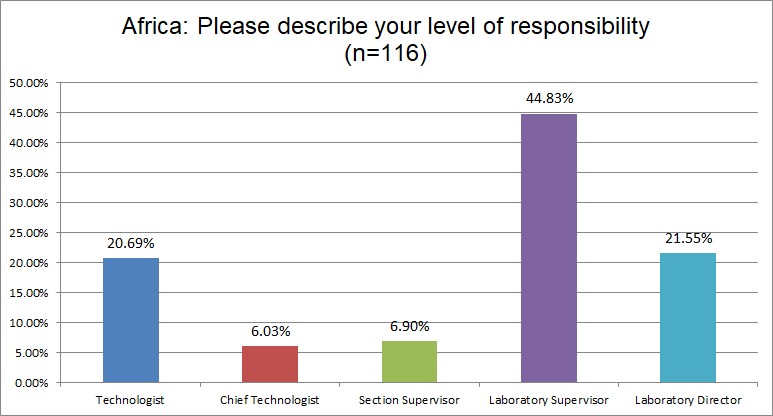
A majority of the responses came from supervisors and directors.

In 2021, 57% of the respondents were from public labs, and only 17% were from private labs. In 2025, that's dropped to 41.9% and 27.5%, respectively. The 2025 survey has fewer public labs and more private labs.

Our 2025 African respondents reflect the typical trend of increasing volumes. While the number of small volume (<10k) labs remained steady, the number of slightly larger labs (>10k but <100k) declined from 44.7% in 2017 down to 37.6% in 2025. In contrast, the number of labs with larger volumes (>100k but <1MM) increased from 23.4% in 20217 to 28.2% in 2025.
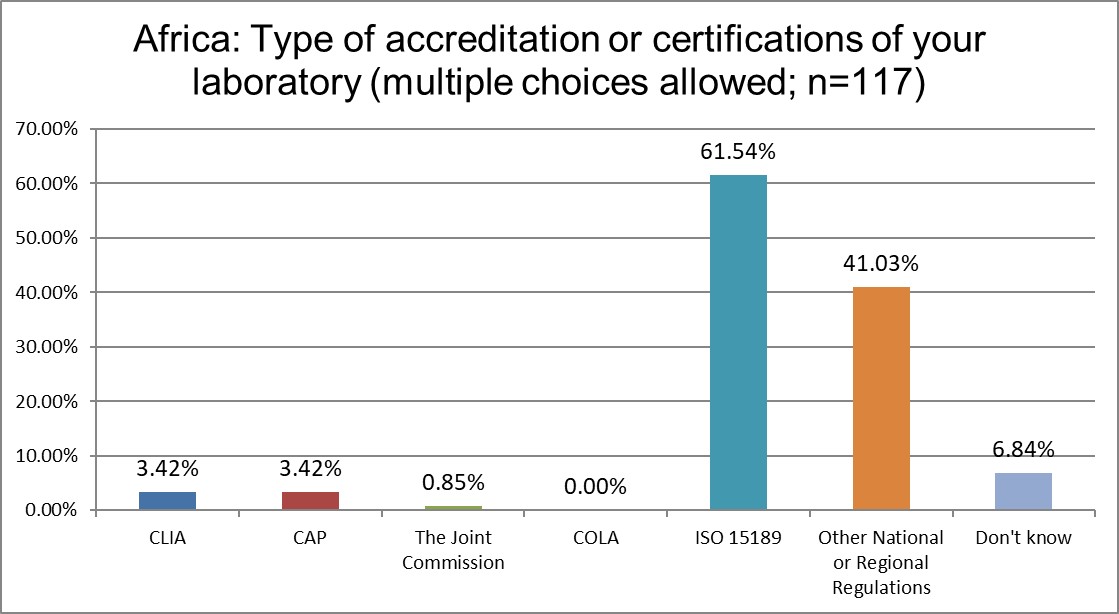
ISO 15189 dominates in Africa, with CLIA, CAP, TJC and COLA playing very little role. In 2021, 48% of labs were ISO 15189 influenced. In 2025, that's grown to over 61%

The majority of the survey reponses focus on chemistry testing, increasing from 63% in 2021 to 70% in 2025.
The QC Set Up

The use of 2 SD on all testing has significantly declined in Africa. In 2021, 68.6% of labs reported using 2 SD on all their tests. Now that's down to just under 56%. This is the biggest decline among the regions of the world. Labs in Africa are abandoning antiqued practices faster than the US and Europe. The use of 2 SD on some tests has basically held steady, 22.9% in 2021, 23.1% in 2025. However, the number of labs that use no 2 SD ranges has more than doubled, from 8.6% in 2021 to over 20% in 2025. That's progress.
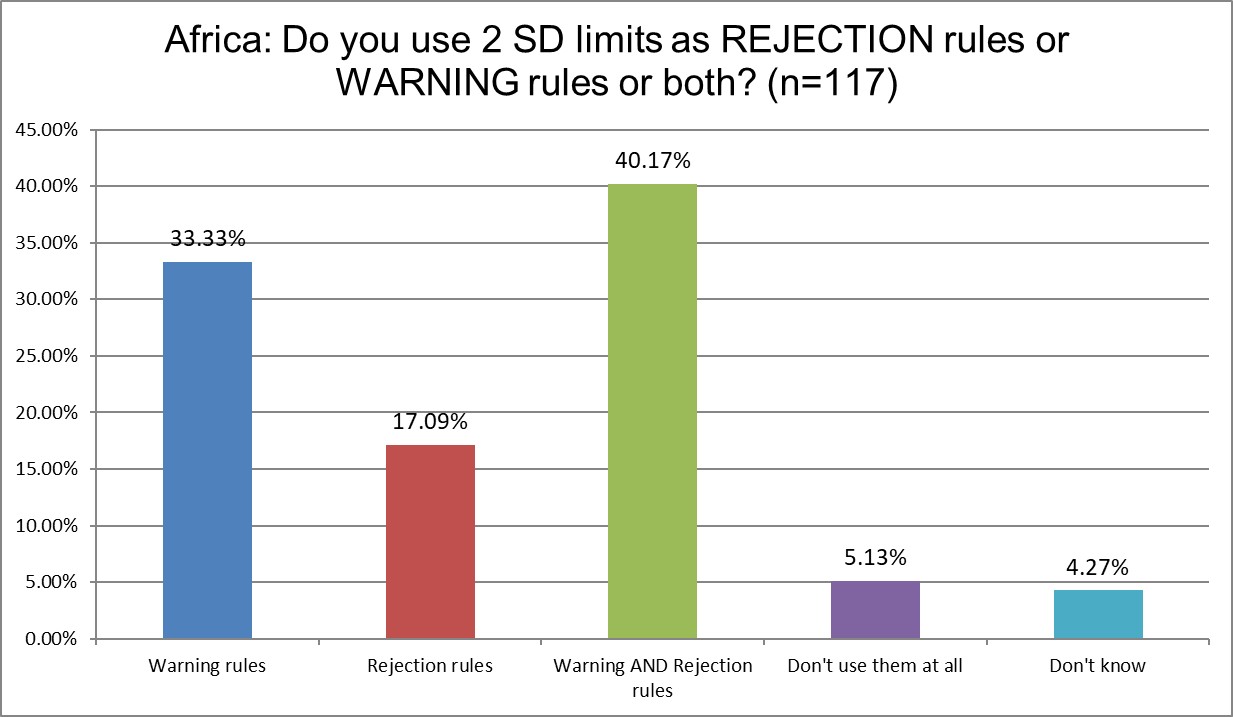
This is a new question we asked for the 2025 survey, so we don't have a prior result to compare it to. Over half of labs in Africa use 2 SD for rejection rules or rejection and warning rules in 2025. While they use 2 SD less frequently, they still seem to replicate some of our bad habits. A third of the labs use 2 SD for warnings only, a good sign.

"Westgard Rules" are in use in over 82% of African laboratories. This is significantly lower than in 2021, when it was over 94%. Interestingly, the number of labs using Westgard Rules on all tests actually went slightly up, from 64% to 68.6%. It's the number of labs using Westgard Rules only on some tests that went significantly down, dropping from 25.7% down to 18.8%.
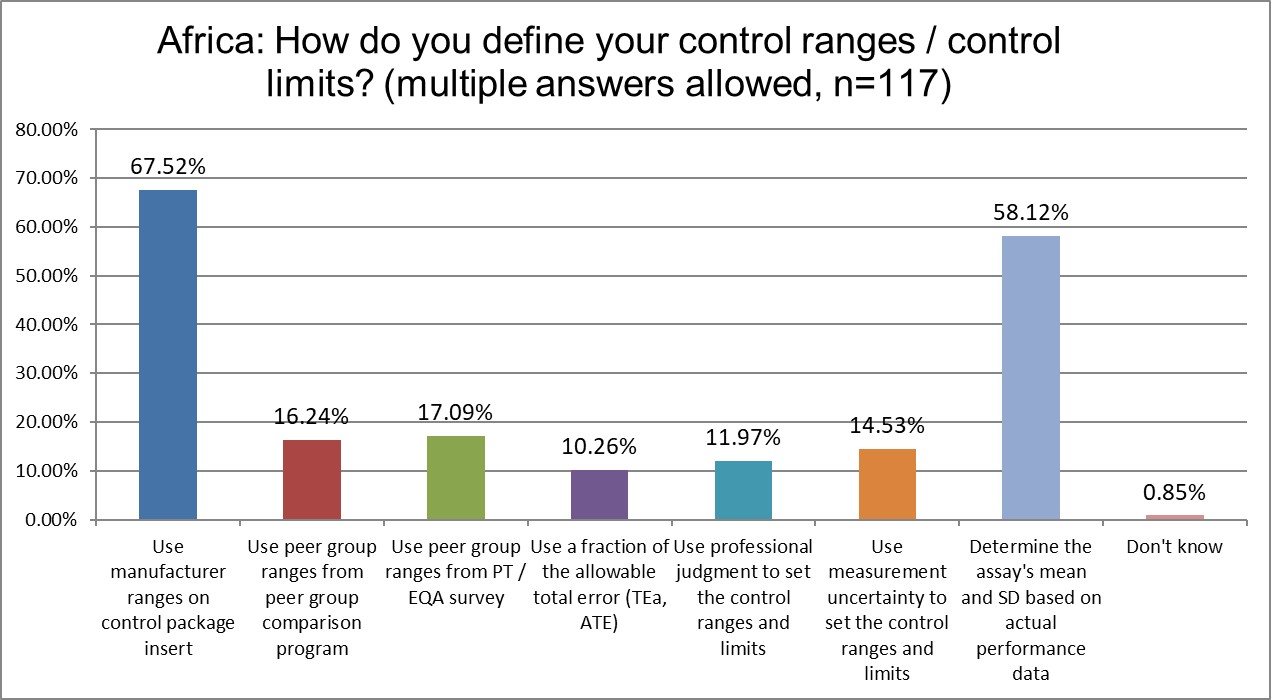
Labs in Africa are using manufacturer ranges lower than they used to, declining from 74% in 2021 down to 67% in 2025. Nevertheless, Africa leads the world in using manufacturer ranges - no other region of the world does it more. Labs in Africa also are calculating their own mean and SD less often, dropping from 62% in 2021 down to 58.1% in 2025. Using manufacturer ranges often means not calculating your own ranges. Here, the trends are in the wrong direction.

ISO 15189 has slightly declined in influence in Africa, from 82.3% in 2021 down to 76.9% in 2025. One of the few times where you see less power of ISO 15189. CLIA regulations have grown in influence from 17.1% in 2021 to 23.9% in 2025. CAP and the other private accreditations remain almost without profile in Africa. The most specific advice on QC, CLSI C24, has doubled from 5.7% in 2021 to 11.1% in 2025.

Nominally, the use of manufacturer controls has increased rather than decreased in Africa. In 2021, 71.43% of labs used manufacturer controls. In 2025, it's now 72.65%. But this is probably not significantly different. Nevertheless, this is one of the highest uses of manufacturer controls in the world. In resource-strained regions, the appeal of "free" QC is difficult to turn down. Meanwhile, the use of 3rd party liquid assayed controls slightly decreased from 34.3% to 30.8. The use of 3rd party lyophilized assayed controls remained steady at around 37%. Similar to declines around the world, the use of patient data QC has gone from small to miniscule, from 14.3% in 2021 down to 6.8% in 2025.

Labs in Africa have steadily done nothing at all with patient data QC, 65% in 2021 to 67% in 2025. In 2021, just over 14% of labs said they used patient data QC for a significant part of their menu. In 2025, that's dramatically dropped to just 5.1%. As in most parts of the world, patient data techniques are being used on only a tiny minority of tests.
The Real Practice of Running Controls

Running three times a day QC in Africa held steady at around 11%, one of the lowest rates in the world. Running QC once a day significantly increased from 48% up to 60.7%. Running QC 2x a day decreased from 37% in 2021 to 28% in 2025. In summary, less QC is being run by labs in Africa, at least the rate of running QC.

Labs in Africa dramatically increased the number of controls they repeat. Repeating after the first outlier was only 42.9% in 2021, now it's greater than 72.6% in 2025. This is the biggest surge in repeating we've seen in the survey. Running a new control after the first repeat fails was performed by 48% of labs in 2021, now that is down to 46% in 2025, a change too small to be significant. Repeating the new control was 5.7% in 2021, but now it's 20.5% in 2025, almost quadrupling! Repeating and repeating and repeating when tfrom 0 in 2021 to 8.55% in 2025. The number of labs that troubleshoot before repeating was 80% in 2021 but it has declined to 74% in 2025. If we pick up the thread of manufacturer controls we saw earlier, perhaps labs feel like "free" QC is something you can repeat more often. Or the sales reps of the control vendors have done excellent work here in Africa.

Labs in Africa have seen a large rise in out-of-control events. In 2021, the survey found just over 5.7% of labs were out of control every day or even multiple times per day. In 2025, that's risen to 24.8%. Almost 5 times the ooc rate. The change is so large, we begin to question the validity of the small sample we obtained in 2021. Nevertheless, labs in Africa are 20% less out of control every day that in the USA! (roughly 45% vs 25% in 2025)

The percentage of African labs that retest all patients after an out-of-control episode declined from 34.3% in 2021 down to 29% in 2025. Retesting select patients decreased from 31.4% in 2021 to almost 21.4% in 2025. Retesting small groups of patients sequentially significantly rose from 20% in 2021 to over 38% in 2025. Retesting patients close to the level that was out-of-control remains basically the same.

The good news is that the number of labs that send out test results even when there's an out of control run remained small . In 2021, just over 8.6% of labs said they did this on a regular basis (daily and weekly). In 2025, that's now just over 10%. Less positively, the number of labs that say they never override their QC rose declined from 48.6% in 2021 down to 42,7% in 2025.

This question about bias uncertainty, or more correctly put, the measurement uncertainty around the correction of bias, is a new one to the 2025 survey. Almost half of labs in Africa state they they do not incorporate bias in their mu. Almost 19% of labs state they do not calculate mu at all.
The Final Overview

More labs have addressed their QC costs since 2021. In our previous survey, 66.67% of labs in Africa said they hadn't done anything. In 2025, it's now down to 54.7%, a significant decrease. The % of labs consolidating controls rose from 12.12% in 2021 to 16.24% in 2025. using cheaper controls, consolidated controls, or wider control limits has not significantly changed. Changing QC rules rose from 2.22% in 2021 to 6.85% in 2025. Reducing QC frequency reduced from 24% in 2021 down to 17% in 2025. Widening control limits and using cheaper controls did not significantly change. Fewer labs are changing QC rules, down from 9.09% in 2021 to 3.42% in 2025.
In summary, a majority of labs in Africa have not managed the costs of their QC.

